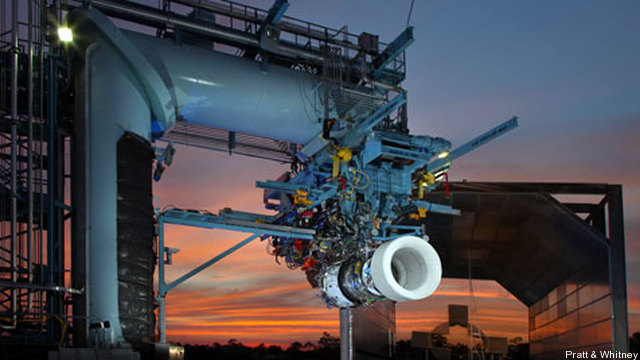New Engine Tech Protects Jets From The Wrath Of FOD
Posted on

PRATT & WHITNEY ENGINE PLANT, MIDDLETOWN, CONN.:
[updated 9:05 am Wednesday with comment from Pratt & Whitney President David Hess]
This factory builds jet engines for high-performance fighters — an engine a week for the F-35 alone — but the armed forces might want to take a look at an innovation on Pratt & Whitney’s commercial side. The new technology, called a “geared turbofan,” was motivated by rising fuel costs and the airlines’ demand for more fuel-efficient engines, itself no small matter for the military. As a byproduct, however, the new engines are also more resistant to a hazard that’s a much bigger deal at rugged forward airbases than tidy civilian airports: Call it the wrath of FOD, foreign object damage, the term of art for the ugly, often explosive things that happen when a jet engine accidentally sucks in anything from loose gravel to Canadian geese.
A jet engine is a complex assembly of rapidly moving parts. They’re designed to suck in air, and they can tolerate water — they have to fly in rainstorms, after all — but if a solid “foreign object” gets inside, it’s kind of like dropping gravel in your Cuisinart: at best you damage something expensive, at worst you blow it up. So even in the military, jet aircraft operate off properly paved runways, while only helicopters and propeller planes routinely land on dirt — with the significant exception of the C-17 cargo jet, which can endure dirt airstrips.
None of this was on Pratt & Whitney’s mind when they spent a decade and a billion dollars developing their geared turbofan technology: Their goal was greater fuel efficiency. To get there, though, they built an engine with a much higher “bypass ratio,” in which more than 90 percent of the air sucked in the front bypasses the core of the engine (where fuel is mixed with air and ignited) and instead just flows through and on out the back. The unintended but happy byproduct is that any foreign objects accidentally sucked in likewise have a 90% chance of bypassing the engine core and not hitting any of its sensitive components. Even better, another part of the geared turbofan’s fuel efficiency is that the intake fans don’t run as fast, so they’re not as likely to suck in foreign objects in the first place: “It’s less of a vacuum cleaner,” said Pratt & Whitney marketing director Jim Speich. The shape of the new engine even allows it to be mounted higher on the wing than traditional turbofans, keeping it that much further away from any litter on the runway.
There are limits to the military applications of this new technology. High-performance combat aircraft don’t use turbofans of any kind but a sleeker kind of engine called a turbojet, so Pratt & Whitney’s innovation literally wouldn’t fit. But a host of military aircraft are derived directly from commercial airliners and use the same kinds of engines.
The geared turbofan variants Pratt & Whitney is currently offering to commercial airlines range in power up to 33,000 pounds of thrust. That’s enough for the KC-135 tanker and radar planes like AWACS and JSTARS, but it fall short for the C-17 transport — which would benefit most from a more FOD-resistant engine — or, for that matter, commercial wide-body jets like the Boeing 747, which need upwards of 40,000 pounds out of each engine. The company is looking at geared turbofans for wide-body jets that would generate “90 to 100,000” pounds of thrust, Pratt & Whitney President David Hess told reporters Wednesday morning, and they expect no problem scaling up the technology: To the contrary, Hess said, “the benefits of the geared architecture are enhanced as you get to bigger engines.”
But Pratt & Whitney doesn’t have an actual higher-powered variant they’ve started design work on, and the chief of the Middletown engine facility, Tom Mayes, told Breaking Defense that it would take “probably two or three years of design” — a long time in the commercial world, perhaps, but practically greased lighting for a defense program.
Full disclosure: Pratt & Whitney paid for airfare and accommodations during my trip to their facility.
Subscribe to our newsletter
Promotions, new products and sales. Directly to your inbox.
